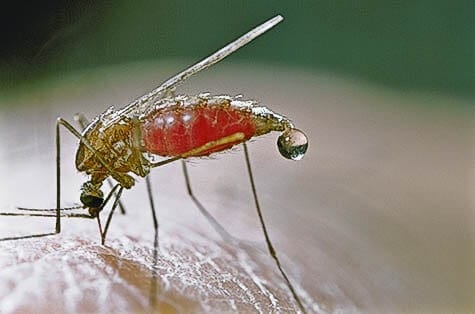A new class of dual-acting antimalarial compounds that target both the liver and the blood stage of the parasite’s life cycle are described online today in ‘Science’. Researchers are hopeful that they could provide a next-generation treatment for the disease.
Malaria is caused by parasites of the Plasmodium species, which are transmitted by the bite of an infected mosquito. Once in the bloodstream, the parasites migrate to the liver where they infect the cells of the liver and multiply.
After around a week, the parasites are released back into the bloodstream, where they continue to infect red blood cells. It is this blood stage that causes the symptoms associated with disease, such as headaches, fever, sweats and chills.
Because the parasite can remain dormant in the liver cells for months to years, they provide a constant reservoir of infection that can be released into the blood stream. To fully eliminate malaria infection, researchers believe that antimalarial drugs need to attack both the liver and the blood stage.
Most current malaria treatments only target blood infections. Some drugs are available that also target the liver stages, but they are often associated with dangerous side-effects.
In this study, part-funded by the Wellcome Trust, researchers developed a new laboratory assay to test the ability of candidate antimalarial compounds to target the liver stages of the parasite. Using this assay, and other tools, they identified a series of compounds – the imidazolopiperazines (IZPs) – that are active against both blood- and liver-stage parasites in mouse models of malaria infection.
The research was conducted by scientists at the Novartis Institutes for BioMedical Research (NIBR), NIBR’s Genomics Institute of the Novartis Research Foundation (GNF) and the Novartis Institute for Tropical Diseases (NITD), in collaboration with the Scripps Research Institute and Swiss Tropical and Public Health Institute.
Martin Seidel, GNF Institute Director, explains: “Compounds with dual activity are rare among current antimalarials. The activity of the IZP compound class on liver-stage parasites, if it can be confirmed in clinical trials, gives promise to this class as a first-line therapy for the prevention and treatment of malaria.”
Several other compound classes, also with dual activity, are described in the study and have been made publicly available by Novartis through the online database ChEMBL Neglected Tropical Disease to facilitate global drug discovery efforts.
Mark Fishman, NIBR President, said: “Concerns of potential future resistance to current medicines, and the need to treat liver forms of malaria, propel our scientists to devise new medicines. The chemical data from this successful study, and the methods of chemical analysis, have all been released to the public domain. Hopefully, such sharing will facilitate broad-based discovery efforts across the globe towards elimination of this disease.”
The study was supported by the Wellcome Trust, Singapore Economic Development Board and Medicines for Malaria Venture.
Commenting on the findings, Ted Bianco, Director of Technology Transfer at the Wellcome Trust, said: “Recent evidence indicates that malaria parasites are developing resistance to frontline antimalarial therapies and new drugs are urgently needed. The discovery of this new class of antimalarial compounds illustrates the power of public-private partnerships to drive forward drug development in an area that may otherwise not be commercially viable.”
Tim Wells, CSO of Medicines for Malaria Venture, said: “MMV has been collaborating with Novartis, the Dutch Primate Centre Swiss Tropical and Public Health Institute and the Wellcome Trust on this exciting project for almost four years now.
“Preventing the infection in the liver is an important part of preventing infections in the community. The potential of this class of compounds to prevent transmission of the disease is one of the key attributes we need in new drugs targeting malaria eradication.”
This is the second new class of antimalarial compounds to be discovered by the same research group in the past two years. Last year the group reported the discovery of the spiroindolone class, represented by the lead compound NITD609, which is now in phase I human clinical trials; phase II is expected to commence in early 2012.

